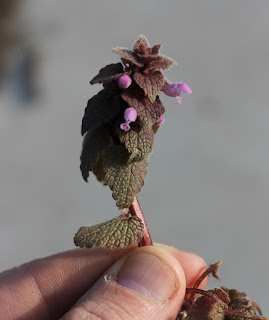When coming out of Western New York’s typically-depressing winters you
probably look for even the slightest signs of spring to get you through.
You might keep your eyes to the skies for migrating birds or you’ll
look to the ground for the first glimpse of plant life. When it comes to
the latter, one of the very first flowers to grace our presence every
year is a weed that is otherwise taken for granted or looked at with
disdain by gardeners – the purple dead nettle.
The purple dead nettle is not actually a nettle. It is a member of the
mint family. It has the tell-tale characteristic of mints, which is a
square stem. It lacks, though, the fragrance that most people expect
from mints. It gets the name dead nettle because this mint has numerous
small hairs like nettles, but, unlike nettles, they won’t stick in your
skin and make you itch like a fiend – so, it was considered “dead” by
early taxonomists.
The plant is incredibly common and can be found almost anywhere
disturbed by man – fields, edges of parking lots, sidewalks, roadsides,
lawns, and so on. It is a small plant, most often 2 to 3 inches off the
ground and not typically reaching 8 inches in height. It is found in
congested clumps, almost like ivies, with many plants in a very small
area. The tiny tubular flowers, which look like minute snapdragons, are
bright purple, maybe pink. The leaves are shaped like a heart or an
arrowhead. The leaves start out green but can quickly become a dark red
or deep purple in color and will stay that way for weeks or months.
Purple dead nettles are pretty unique in that they can have flowers over
most of the year. In a mild winter you will see their flowers as early
as the last week of February. Most years, though, you’ll start to see
them the second week of March. Their greatest abundance will be in April
and May. The flowers tend to disappear from the heat in July and
August, but you will see them again in the fall right into November.
Because of their early blooms, they are absolutely critical to the
well-being of bees and other pollinators that might come out of their
winter slumber on warm days. When no other flowers are available in
March, the purple dead nettle gives them the nectar they need. Also, in
April, the pollinating plants give bees pollen to help build up their
nests.
Like most all mints, the purple dead nettle has some value to people.
While you probably wouldn’t make a tea out of it, its young tender
leaves nicely augment salads and stir fries. The leaves also make a
healthy addition to smoothies, adding a lot of powerful antioxidants to
the mix.
While most people might look down upon this plant as a weed, you should
welcome its presence in your backyard. Its cute little flowers are a
welcome sight when the snow starts to melt and they keep the local bee
populations healthy in the early spring – goodness knows they need it
with all of the mass bee die-offs in recent years.
Bob Confer is a Gasport resident. His column, Exploring the Niagara Frontier, is published every Thursday on All WNY News.
From the 14 April 2016 All WNY News


No comments:
Post a Comment